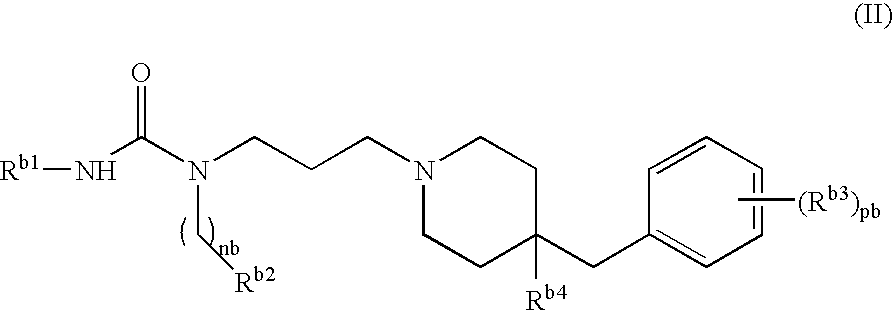Use of compounds having ccr antagonism
a technology of ccr and compound, applied in the field of graftversushost disease, can solve the problems of poor prognosis, low patient qol, no reports of low molecular weight chemokine antagonist compound, etc., and achieve the effect of prevention and treatmen
- Summary
- Abstract
- Description
- Claims
- Application Information
AI Technical Summary
Benefits of technology
Problems solved by technology
Method used
Image
Examples
reference example 1-1
t-Butyl 4-(2-ethoxy-2-oxoethylidene)-1-piperidine carboxylate
[0659] To a solution of ethyl diethylphosphoryl acetate (28.3 g) in tetrahydrofuran (200 ml) was added 60% sodium hydride (4.82 g) under ice cooling and the mixture was stirred for 30 minutes, and then a solution of N-butoyxcarbonyl-4-piperidone (20 g) in tetrahydrofuran (200 ml) was added dropwise thereto. The mixture was stirred for 22 hours at room temperature. After the completion of the reaction, water (200 ml) was added and extraction was carried out with ethyl acetate. After the extract was washed with saturated aqueous sodium chloride solution and dried over anhydrous magnesium sulfate, the concentrated residue obtained was then purified using silica gel column chromatography and eluted with hexane / ethyl acetate (6 / 1) to obtain the title compound (27.3 g, 100%) as a colorless powder.
[0660]1H NMR (CDCl3) δ 1.28 (3H, t, J=7.4 Hz), 1.47 (9H, s), 2.24-2.33 (2H, m), 2.90-2.98 (2H, m), 3.43-3.55 (4H, m), 4.16 (2H, q, J...
reference example 1-2
[1-(Methylsulfonyl)-4-piperidylidene]ethyl acetate
[0661] The compound (10 g) obtained in Reference Example 1-1 was dissolved in methanol (100 ml), and 4N hydrochloric acid-ethyl acetate (20 ml) and trifluoroacetic acid (2.5 ml) were added and the mixture was stirred for 3 hours. The solvent was evaporated, and the residue obtained was washed with ethyl acetate to obtain a colorless powder (6.64 g).
[0662] The colorless powder (6.64 g) obtained were added to tetrahydrofuran (100 ml) and triethylamine (9.9 ml), mesyl chloride (3 ml) was added dropwise with ice cooling, and the mixture was stirred at room temperature for 1 hour. After completion of the reaction, water (100 ml) was added and the mixture was extracted with ethyl acetate. After the extract was washed with saturated aqueous sodium chloride solution and dried over anhydrous magnesium sulfate, the concentrated residue obtained was then purified using silica gel column chromatography and eluted with hexane / ethyl acetate (1 / 1...
reference example 1-3
[1-(Methylsulfonyl)-4-piperidinyl]ethyl acetate
[0664] The compound obtained in Reference Example 1-2 and 10% palladium-carbon (0.3 g) were added to ethanol (50 ml) and the mixture was stirred under hydrogen for 5 hours. After the reaction was completed, insoluble materials were filtered off with celite, the filtrate was concentrated and the residue obtained was purified using silica gel column chromatography, and the title compound (1.62 g, 100%) as a colorless oily material was obtained from the fraction eluted with hexane / ethyl acetate (1 / 1).
[0665]1H NMR (CDCl3) δ 1.26 (3H, t, J=7.0 Hz), 1.33-1.48 (2H, m), 1.78-2.02 (3H, m), 2.28 (2H, d, J=6.6 Hz), 2.68 (2H, dt, J=2.4, 12.0 Hz), 2.77 (3H, s), 3.74-3.85 (2H, m), 4.15 (2H, q, J=7.0 Hz).
PUM
| Property | Measurement | Unit |
|---|---|---|
| carbon number | aaaaa | aaaaa |
| carbon number | aaaaa | aaaaa |
| temperature | aaaaa | aaaaa |
Abstract
Description
Claims
Application Information
 Login to View More
Login to View More - R&D
- Intellectual Property
- Life Sciences
- Materials
- Tech Scout
- Unparalleled Data Quality
- Higher Quality Content
- 60% Fewer Hallucinations
Browse by: Latest US Patents, China's latest patents, Technical Efficacy Thesaurus, Application Domain, Technology Topic, Popular Technical Reports.
© 2025 PatSnap. All rights reserved.Legal|Privacy policy|Modern Slavery Act Transparency Statement|Sitemap|About US| Contact US: help@patsnap.com



